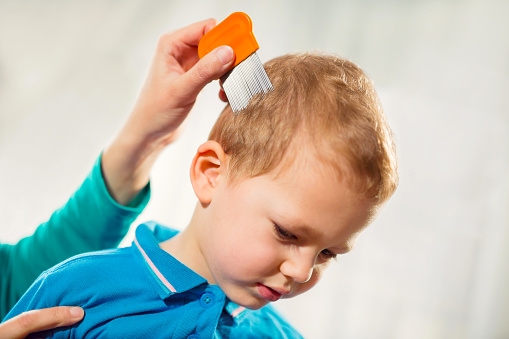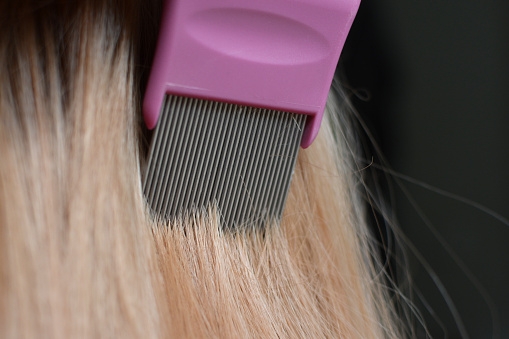Dealing with nits in small children

Nits are parasites and most common in 4-11 year olds because at this age, children have lots of physical contact and nits are easily transmitted head-to-head. Younger siblings in the family can get them easily too. Your child can get infected at nursery, playschool or school. Adults can also have nits which is why, if you find them in your child’s hair, it is really important to treat the whole family.
If your child has started nursery or school, it may not be long before you receive a letter saying that an outbreak of nits has been found among their peers.
What exactly are nits?
In a nutshell, nits are the eggs laid by head lice, but the term is often used to describe both.Head lice are small insects – about 2 mm– that look similar to a chestnut brown sesame seed. They like to live in hair and they lay their eggs – the nits - along shafts of hair. The nits are really tiny creamy or pale gold oval eggs and can easily be mistaken for dandruff. The big difference is that they are stuck to the hair shaft, rather than the scalp.
It takes 7-10 days for the nits to hatch and once born, the head lice survive by sucking tiny quantities of blood from the scalp – it is this action that causes itchiness to children.
Are nits dangerous?
Nits are not a sign of poor hygiene and are totally harmless, but, left untreated, your child can become infested with them. This is very difficult for your child and much harder to treat.Nits are more prevalent in girls than boys, because girls tend to have longer hair.
Head lice droppings can sometimes be spotted on a pillowcase and can cause an allergic rash on your child’s face.
How are they transmitted?
Head lice cannot fly or jump, but they are happy to walk from one head to another and of course, young children often get in very close contact with each other.Sharing a hat or comb is inadvisable, but is unlikely to be the source of infection. Sharing a pillow cannot spread head lice, nor can they be caught from the family dog.

How can you spot head lice?
Head lice and nits are remarkably difficult to spot in the hair . When children start having an itchy head, they will have had nits for a couple of weeks and the itching is caused by the head lice when they have hatched. Some children never feel itchy. It is best to check your child’s hair every week and to get into the routine of doing so.The only way to spot nits is to regular check your little one’s hair. For this, you will need a nit detection comb. These can be easily bought in pharmacies and are fine-toothed combs – with teeth about 0. 2 mm apart. Choose a plastic comb as metal tugs on hair. The comb can be used on dry hair, but it is far better to wet the hair and apply conditioner generously as the head lice cannot move so easily and you have the chance to spot them.
When you have conditioned your child’s hair, comb it with an ordinary comb first to get rid of any tangles.
Using the nit comb, comb the hair through section by section, from the hair root to the tip, keeping the comb as close to the scalp.
Each time you reach the tip of the hair, check the comb for nits. Clean the comb with damp kitchen roll and start on the next section.
If you do find evidence of nits, clean the comb and redo the same section a second time, to remove as many as possible.
If you cannot see clearly enough, examine the hair with a magnifying glass.
If you do detect head lice/ nits on your child’s head, wet comb all other family members the same day to check if anyone else has them too.
Dealing with an infection of nits/head lice
There are a number of special shampoos that you can buy over-the-counter in the local pharmacy to treat nits. It is best to seek advice because nits can become resistant to certain chemical ingredients. You will need to check with the pharmacist about using the recommended shampoo if you are pregnant, breastfeeding or your child is under two years of age.These special shampoos usually have to be left on the hair for at least ten minutes and two applications need to be made – one straight away and the other, seven days later. It is important that all family members are treated at the same time to prevent re-infection. Comb the hair through carefully with the nit comb every day. When you have seen no nits or head lice for ten days, you have one the battle. Check hair every week as getting nits again is common.
Are there any natural remedies?
There are several ways to deal with head lice and nits naturally and these can successfully be used in conjunction with the nit comb. These treatments are ideal for younger children, who are too young for the chemical nit shampoo.Massage your child’s head in apple cider vinegar and leave for 10-15 minutes. The vinegar makes it harder for the nits to grip on to the hair shaft so they can be more easily removed by the nit comb. Comb the hair thoroughly with the nit comb and then rinse the hair in clean water
Tea tree essential oil kills nits and can be diluted 1:3 with warm water and mixed well. Use a spray bottle to apply the tee tree to the hair. Leave for 10-15 minutes and then comb the hair thoroughly with the nit comb. Rinse your child’s hair in clean water. Repeat this process twice a week. Add a few drops of tea tree oil to your child’s normal shampoo too.
Massage olive oil thoroughly into your child’s scalp. The olive oil suffocates the head lice so that they cannot breathe. Leave the oil in the hair for 10-15 minutes and then comb the hair through carefully with the nit comb before washing in clean water.
Once you have detected nits in your child’s hair, contact their nursery or school so that other parents can be warned and also to check if the teachers are happy for your child to attend during treatment – most are.Chrissie x

